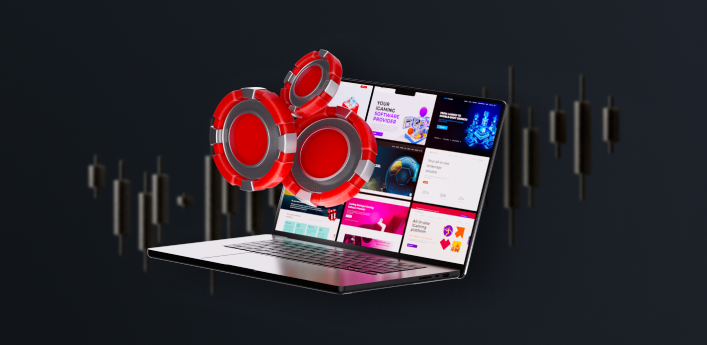
Brokerage Industry Trends 2025: The Entrepreneur Guide
Contents
The brokerage business is transforming in 2025 at an unprecedented pace, driven by technological innovation and changing investor sentiment, which is driving high growth. We’re entering a $205.32 billion market this year that’s being reshaped by commission-free strategies, mobile-first strategies, and AI-powered solutions, changing the dynamics of how brokerages compete and operate.
This guide highlights some of the leading trends in the brokerage industry that entrepreneurs need to know to position themselves correctly.
Market Dynamics Reshaping the Brokerage Landscape
Explosive Growth Trajectory
The global e-brokerage market is expanding at a whopping 6.5% CAGR through 2030, according to Mordor Intelligence’s comprehensive market analysis. This growth is driven by retail investor participation and all-around digital adoption. To catch this wave of growth, you need to key into any of these three market drivers:
- Digital-first investor habits: Traders today anticipate seamless mobile experiences
- Democratization of investing: Low fees and fractional shares attract new investors
- Regulation evolution: More structured guidelines enable innovation while protecting consumers
Commission-Free Trading Revolution
Commission-free products have fundamentally disrupted revenue models to their foundations while propelling wholesale user acquisition. According to Market Research Future’s report on securities brokerage, this trend forces you to innovate beyond transaction fees. As a result, successful brokerages now monetize through:
- Payment for order flow arrangements with market makers
- Premium subscription-based offerings of advanced analytics and tools
- Margin loaning and security loaning programs
- Cryptocurrency spreads and staking rewards
There is increasing regulatory scrutiny around payment for order flow, so well-defined pricing models are necessary to build trust and profitability.
Technology Trends Transforming Brokerage Operations
Artificial Intelligence Integration
AI and machine learning are enabling brokers to offer improved and personalized investment services and advice, as highlighted in DashDevs’ fintech trends report. Risk profiling and portfolio rebalancing solutions driven by AI are also improving client satisfaction and retention.
Smark brokerages apply AI in these three main areas:
Risk Management Improvement:
- Timely measurement of portfolio risk
- Compliance monitoring through automated means
- Automated fraud prevention and detection systems
Personalized Client Experience:
- Personalized investment recommendations
- Behavioral pattern analysis to improve UX
- Predictive analytics for client needs
Operational Efficiency:
- Back-office processes automated
- Intelligent customer care chatbots
- Dynamic price optimization
To learn more, read our beginner’s guide on how to use AI in trading.
Mobile-First Platform Development
Desktop and mobile application usage showed strong growth in 2024, while mobile browser use dropped sharply. This trend indicates that in 2025, your brokerage platform architecture must center around native mobile apps.
Therefore, adapt key mobile features that boost engagement, such as:
- Tap-trade with sophisticated order types
- Real-time market movement push notifications
- Biometric login for immediate authentication
- Social trading features are natively supported
Evolution of Social Trading and Copy Trading
Platforms are increasingly incorporating social features like newsfeeds, communities, and influencers while enhancing copy trading services. This trend is revolutionizing investing by moving from individual activity to a more social experience.
To get in on this, you should implement:
- Community features such as:
- Investor discussion boards and forums
- Performance-based rankings and leaderboards
- Educational content from profitable traders
- Copy trading innovation, such as:
- Automatic replication of strategies
- Risk-adjusted copying of parameters
- Transparent performance metrics
- Commission-sharing models for strategy sellers
Regulatory Evolution and Compliance Trends
Improved Consumer Protection
Regulatory bodies globally are strengthening investor protection measures. Your brokerage must exceed minimum compliance to build trust and avoid fines. Key areas of attention are:
- Transaction transparency: Unobscured cost disclosure and execution quality reporting
- Data protection: GDPR-readiness and robust cybersecurity practices
- Risk warnings: Extensive education on investment risks
- Conflict of interest disclosure: Transparent revenue source disclosures
Open Banking and API Integration
Open banking regulations are enabling seamless account linking and data sharing. Forward-thinking brokerages are creating APIs that allow for:
- Auto-account funding from multiple bank accounts
- Unified financial dashboards for every investment
- Third-party integration with financial planning and budgeting software
- Auto-tax reporting through accounting software hooks
You may also like

Emerging Asset Classes and Trading Instruments
Cryptocurrency Integration
Digital assets are becoming mass-market investment products. Your platform needs robust crypto infrastructure backing, which includes:
Trading Facilities:
- Large-scale cryptocurrency spot trading
- Crypto options and futures
- Staking and earning
- Support for DeFi protocols
Security and Custody:
- Multi-signature wallet architecture
- Cold storage mechanisms
- Digital asset insurance cover
- Jurisdictional regulatory compliance
Fractional Share Investing
Highly priced shares and ETFs become more democratic with fractional ownership. Young investors with little initial capital find this appealing. Setup involves:
- Fractional amount order execution systems
- Dividend distribution calculations for fractional shares
- Fraction position corporate action processing
- Portfolio rebalancing solutions enabling fractional investment
White Label Solutions: Your Competitive Edge
Rapid Market Entry
By choosing a comprehensive white label solution, you bypass years of R&D and regulatory warm-up. This approach offers immediate advantages:
Time-to-Market Advantage:
- Bring your brokerage online in weeks, not years
- Pre-configured regulatory templates and documents
- Established connections with liquidity providers
- Institutional-grade technology stack with high resilience
Cost Savings:
- No seven-figure cost of development
- Steady monthly operating expenses
- Shared infrastructure keeps overhead to a minimum
- No huge technical team upfront is required
Incorporated Best Practices
Leading white label providers automatically incorporate the latest fintech industry innovations and trends. Quadcode-driven brokerage benefits from:
- New AI features for risk and client analytics
- Mobile-optimized products with leading UX design
- Social trading capability to suit modern investor needs
- Multi-asset support, including crypto, forex, and conventional securities
You can also check our list of top fintech blogs to follow in 2025 for trends and insights.
Brand Control and Customization
New white label offerings offer excellent degrees of customization without compromising the underlying functionality. As Quadcode’s recent strategic partnership with Polymarket demonstrates, successful financial technology businesses take proven technology with a maintained brand identity.
You are in control of:
- Brand identity: Complete visual customization to your design
- Feature selection: Choose what trading instruments and tools to offer
- Pricing structure: Set spreads, commissions, and fee plans
- Client onboarding: Build KYC processes to your design
You may also like

How to Future-Proof Your Brokerage Business
Quantum Computing and Security
Quantum computing threats are driving next-generation security implementations that forward-thinking brokerages are already preparing. These security measures include quantum-resistant encryption protocols, advanced biometric authentication systems, zero-trust security architectures, and continuous AI-powered threat monitoring against new attack vectors.
Central Bank Digital Currencies (CBDCs)
Central Bank Digital Currencies are about to shake up global finance in ways we’re only beginning to understand. To stay ahead, your platform should prepare for CBDC integration by building a flexible payment infrastructure and establishing relationships with central banks. In addition, develop compliance frameworks for digital currencies and create educational resources for clients who may be confused by these new instruments.
Sustainable Investing Focus
Environmental, Social, and Governance (ESG) investing is moving from niche to mainstream faster than most experts predicted. Your brokerage needs comprehensive ESG scoring systems, sustainable investment screening tools, impact measurement, and reporting capabilities. You also need green bond and ESG ETF offerings that meet growing demand.
Carbon footprint tracking has become essential. Brokerages must now provide portfolio carbon intensity calculations, climate risk assessment tools, and offset program integration. In turn, you can adopt sustainability reporting dashboards that help environmentally-conscious investors align their values with their investments.
Competitive Differentiation Strategies
Niche Market Focus
Instead of competing head-on with deep-rooted giants, pursue specialized strategies. Different client groups have distinct expectations:
- Gen Z investors expect mobile-first experiences
- High-net-worth clients expect premium services
- International investors expect cross-border services
- Crypto-native traders expect traditional asset availability
Specialized Services:
- Options and derivatives capabilities
- Alternative investment platforms
- Robo-advisory services
- Tax optimization tools
Educational Excellence
Education content becomes a competitive advantage as regulation focuses on investor protection. You can maximize this by inputting:
- Interactive webinar series with market experts
- Comprehensive learning centers in investment basics
- Risk assessment tools help clients understand their tolerance
- Market analysis providing actionable insights
Implementation Roadmap for Success
Phase 1: Building the Foundation (Months 1-3)
Platform Setup:
- Choose and set up a white label solution
- Complete regulatory forms and acquire licenses
- Establish liquidity provider relationships
- Create a core team and operating processes
Market Research:
- Study local competition and pricing
- Identify target customer segments
- Create marketing and acquisition plans
- Create compliance and risk management structures
Phase 2: Launch and Growth (Months 4-12)
Client Acquisition:
- Run digital marketing campaigns
- Launch referral and incentive programs
- Form strategic alliances
- Develop thought leadership content
Platform Enhancement:
- Add high-end trading features
- Implement social trading capability
- Add asset class offerings
- Improve mobile experience based on usage data
Phase 3: Scale and Innovation (Year 2+)
Advanced Competencies:
- Roll out AI-powered personalization
- Add premium levels of service
- Add institutional client features
- Develop in-house research and analysis tools
New Region Expansion:
- Obtain additional regulatory licenses
- Adapt the platform for foreign markets
- Form local partnerships
- Customize offerings to regional flavors
Key Performance Metrics to Monitor
Client Metrics
Track these critical KPIs for long-term growth:
- Client acquisition cost (CAC) in relation to lifetime value (LTV)
- Monthly active users and percentages of user engagement
- Average revenue per user (ARPU) trend
- Client retention rates per business segment
Operational Excellence
Monitor operational effectiveness through:
- Order processing velocity and quality metrics
- Platform performance and uptime metrics
- Customer service response time and quality
- Regulatory compliance ratings and audit results
Financial Performance
The most important financial metrics are:
- Revenue diversification by streams of revenue
- Minimization of cost per trade
- Net interest return on margin lending
- Operating expense ratios compared to industry standards
Risk Management in Modern Brokerages
Risk Mitigation with Technology
Technology failure can destroy client confidence in a heartbeat. To mitigate this, implement:
- Redundant systems design with failover
- Real-time monitoring of all critical systems
- Periodic testing of disaster recovery plans
- Cybersecurity frameworks aligned with international standards
Market Risk Controls
Sophisticated risk management protects clients and your business with multiple layers of protection.
Client protection includes:
- Real-time margin monitoring
- Automated position size limit
- Point of trade risk disclosure
- Volatility alerts in the market
You may also like

Business protection involves:
- Diversified liquidity provider network
- Hedging initiatives on a dynamic basis
- Credit risk monitoring systems
- Regulatory capital buffers
Conclusion
The pace at which the brokerage business is evolving comes with unprecedented opportunities for savvy entrepreneurs willing to embrace new technology and changing investor expectations. With white label solutions, you can enter this lucrative business in no time while staying ahead of upcoming trends and regulatory requirements. You will succeed in 2025 if you can combine the newest technology with quality client experience and prudent risk management.
FAQ
With an end-to-end white label partner such as Quadcode, you can be up and running in 2-4 weeks. Traditional development timelines are 12-24 months or more.
Requirements vary by jurisdiction, but typically between $100,000 and $5 million of regulatory capital, along with first-year operational expenses.
Revenues come from payment for order flow, margin lending, premium subscriptions, cryptocurrency spreads, and securities lending programs.
AI application for personalization and risk management, social trading features, and a mobile-first approach are the most successful trends.
Failure in regulatory compliance and cybersecurity breaches pose the largest threat to new brokerages. They can both result in business closure.
Updated:
October 10, 2025
19 December, 2025
Top 10 White Label Casino Providers 2026
A white label casino is a ready-made online gambling platform that lets entrepreneurs start their own brand without building technology or securing licenses from scratch. In 2026, this model remains the fastest and most affordable way to enter the iGaming market. The leading white label casino providers in 2026 are SoftSwiss, BetConstruct, NuxGame, SoftGamings, FintechFuel, […]




